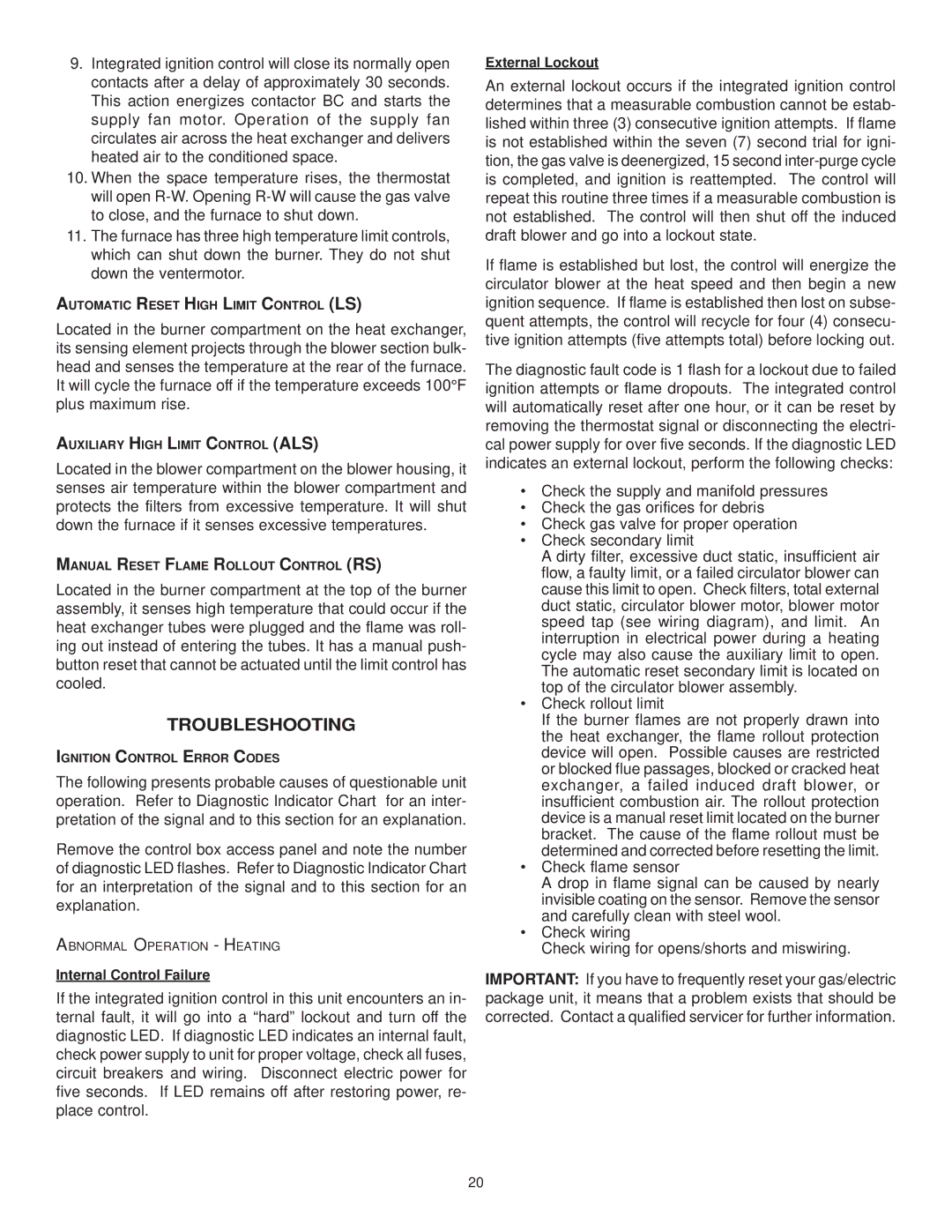9.Integrated ignition control will close its normally open contacts after a delay of approximately 30 seconds. This action energizes contactor BC and starts the supply fan motor. Operation of the supply fan circulates air across the heat exchanger and delivers heated air to the conditioned space.
10.When the space temperature rises, the thermostat will open
11.The furnace has three high temperature limit controls, which can shut down the burner. They do not shut down the ventermotor.
AUTOMATIC RESET HIGH LIMIT CONTROL (LS)
Located in the burner compartment on the heat exchanger, its sensing element projects through the blower section bulk- head and senses the temperature at the rear of the furnace. It will cycle the furnace off if the temperature exceeds 100°F plus maximum rise.
AUXILIARY HIGH LIMIT CONTROL (ALS)
Located in the blower compartment on the blower housing, it senses air temperature within the blower compartment and protects the filters from excessive temperature. It will shut down the furnace if it senses excessive temperatures.
MANUAL RESET FLAME ROLLOUT CONTROL (RS)
Located in the burner compartment at the top of the burner assembly, it senses high temperature that could occur if the heat exchanger tubes were plugged and the flame was roll- ing out instead of entering the tubes. It has a manual push- button reset that cannot be actuated until the limit control has cooled.
TROUBLESHOOTING
IGNITION CONTROL ERROR CODES
The following presents probable causes of questionable unit operation. Refer to Diagnostic Indicator Chart for an inter- pretation of the signal and to this section for an explanation.
Remove the control box access panel and note the number of diagnostic LED flashes. Refer to Diagnostic Indicator Chart for an interpretation of the signal and to this section for an explanation.
ABNORMAL OPERATION - HEATING
Internal Control Failure
If the integrated ignition control in this unit encounters an in- ternal fault, it will go into a “hard” lockout and turn off the diagnostic LED. If diagnostic LED indicates an internal fault, check power supply to unit for proper voltage, check all fuses, circuit breakers and wiring. Disconnect electric power for five seconds. If LED remains off after restoring power, re- place control.
External Lockout
An external lockout occurs if the integrated ignition control determines that a measurable combustion cannot be estab- lished within three (3) consecutive ignition attempts. If flame is not established within the seven (7) second trial for igni- tion, the gas valve is deenergized, 15 second
If flame is established but lost, the control will energize the circulator blower at the heat speed and then begin a new ignition sequence. If flame is established then lost on subse- quent attempts, the control will recycle for four (4) consecu- tive ignition attempts (five attempts total) before locking out.
The diagnostic fault code is 1 flash for a lockout due to failed ignition attempts or flame dropouts. The integrated control will automatically reset after one hour, or it can be reset by removing the thermostat signal or disconnecting the electri- cal power supply for over five seconds. If the diagnostic LED indicates an external lockout, perform the following checks:
•Check the supply and manifold pressures
•Check the gas orifices for debris
•Check gas valve for proper operation
•Check secondary limit
A dirty filter, excessive duct static, insufficient air flow, a faulty limit, or a failed circulator blower can cause this limit to open. Check filters, total external duct static, circulator blower motor, blower motor speed tap (see wiring diagram), and limit. An interruption in electrical power during a heating cycle may also cause the auxiliary limit to open. The automatic reset secondary limit is located on top of the circulator blower assembly.
•Check rollout limit
If the burner flames are not properly drawn into the heat exchanger, the flame rollout protection device will open. Possible causes are restricted or blocked flue passages, blocked or cracked heat exchanger, a failed induced draft blower, or insufficient combustion air. The rollout protection device is a manual reset limit located on the burner bracket. The cause of the flame rollout must be determined and corrected before resetting the limit.
•Check flame sensor
A drop in flame signal can be caused by nearly invisible coating on the sensor. Remove the sensor and carefully clean with steel wool.
•Check wiring
Check wiring for opens/shorts and miswiring.
IMPORTANT: If you have to frequently reset your gas/electric package unit, it means that a problem exists that should be corrected. Contact a qualified servicer for further information.
20
